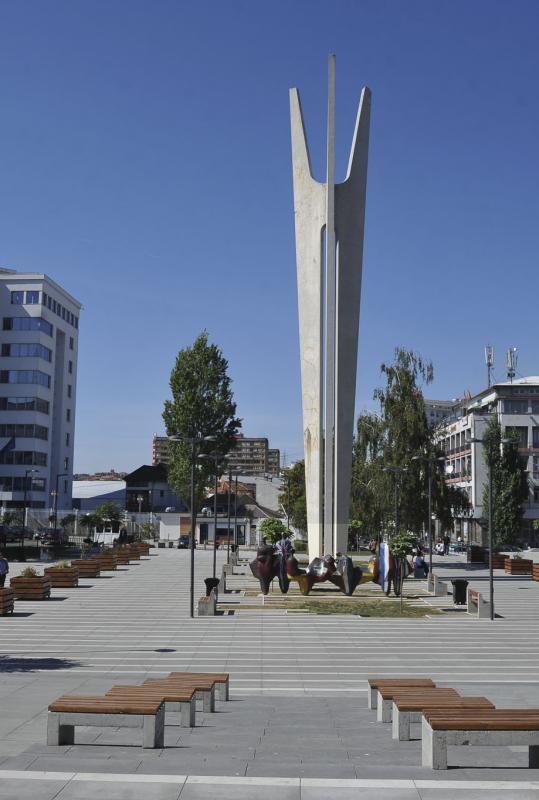From the position of facing Madeleine Albright bust, you will now need to walk on your right-hand side throughout Luan Haradinaj street and Migjeni Street for some 400-500 meters to UCK Street where you will need to make another right turn towards the Municipality of Prishtina building. Between the Kosovo Parliament and Municipality of Prishtina, you will find the Brotherhood and Unity monument which is located officially in the Adem Jashari square. Brotherhood and Unity Monument is marked as “Permendorja” in Google maps.
5. Brotherhood and Unity monument
Stories
Directions
The three branches
In the area of the ‘’carshia’’, a 19th-century Ottoman bazaar, one can see today the central Pristina square. After WWII this place was chosen for a monument in memoria of all the fallen fighters and war victims. It was designed by Miodrag Živković, and the structure is a 20m tall obelisk divided into three pillars of concrete and rebar, connected at the top. Each of the three pillars represents one of the three ethnicities of the region (Albanian, Montenegrin, and Serb). Right in front of the structure, there is a series of eight statues depicting Partisan soldiers. The monument was completed in 1961, and in Albanian, it is known as ‘’the triangle“(‘’trekëndëshi”) or the three branches ('’tre rremëshi'). Nevertheless, it is officially named 'Monument to Heroes of the National Liberation Movement' or "Monument to the Revolution''. During Tito’s governance this memorial complex represented his ‘’Brotherhood and Unity’’ ideology and apart from a political symbol, it was turned into a city symbol, since it was depicted in the postcards as a local landmark. After the Kosovo war, the monument faced the menace of local people that tried to explode it. In 2010,the local government decided to rename the square from Brotherhood and Unity to 'Adem Jashari Square' from the name of the KLA leader.
An expressed argument
It was in 2010 when the Municipality of Pristina announced the forthcoming project of the Square's restoration. In this context the Mayor (S. Ahmeti) expressed openly his argument regarding the name of the Square; he further proposed that a referendum should let the people decide whether or not the Square's central monument, built as part of Tito’s ‘Brotherhood and Unity’ ideology, should continue to exist in the Adem Jashari Square. Otherwise, their options were either to remove the monument or just rename the square. According to Ahmeti, it was a crucial matter that needed to be settled immediately as it was at least a profound paradox. Obviously the Mayor's concept was criticized by the people that found the whole referendum proposal as awkward, with the most sarcastic ones to claim that ‘’Ahmeti has asked Adem Jashari to register as a property owner, as there are far too many things in his name’’.
“Art above art’’
The monument seems that it is quite underappreciated judging by its recent condition. Until 2018 it was a place for ‘’cultural expression’’ since it was covered with graffiti and many young people went there to draw their message. The majority weren’t art but random words or confusing designs. These graffiti have been removed after the 2018 rehabilitation, apart from the spray painting drawings covering the 8 bronze Partisan soldiers statues situated in front of the obelisk. The reason is obvious as they are depicting the flags of the countries that assisted Kosovo during the war.
Answer this!
Why did they create the ‘’three branches’’ monument?
Powered by Clio Muse Tours
